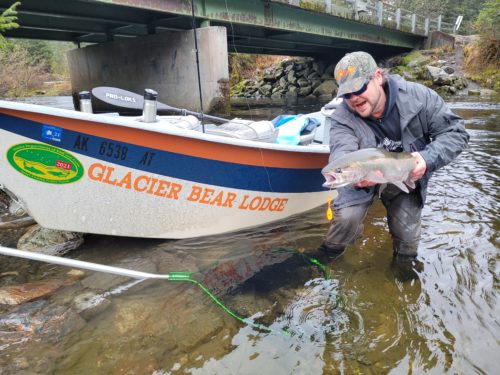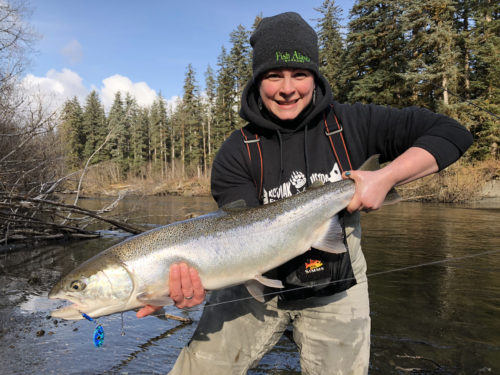
The Spin Cycle: A Day Of Situk Steelhead Spinner Fishing

The following appears in the March issue of Alaska Sporting Journal:
BY RANDALL BONNER
As I pulled into the launch and didn’t see a single rig parked anywhere, I realized we had the Situk River to ourselves. “Take your time and make a few casts while I get the boat together,” I said while unloading the truck.
Tony “Famous” Davis of Kodiak Custom Tackle had come to fish in Yakutat during one of the worst steelhead seasons on record, but his timing couldn’t have been more perfect.
After seeing him fish the inside seam, I suggested he hit the eddy on the far side and roll one of his spinners into the tailout. On the next cast, he hooked up as I was pulling the trailer out of the water, which made for a great shot for Tim at Alaska Outdoors Television, who tagged along to do some promotional filming.
When I came back down the ramp and found myself reaching into the boat for the net before I even had the oars in, I knew it was going to be a good day.
I’LL ADMIT, I HAD my doubts about rowing 14 miles of river and chucking spinners the whole way, something none of us had ever really done for steelhead. Even that hookup at the launch gave me a little anxiety we’d suffer that “early fish curse.”
We’ve all had those days when you get one to the boat first thing in the morning. It gets your hopes up and builds unrealistic expectations, and then you’re humbled the rest of the day. Luckily that wasn’t the case this trip. Knowing that the early-morning bite had been pretty good, I was as hopeful as I was skeptical.
After Tony hooked his second fish in the first 10 minutes of our float, I started to believe in the magic of metal. That morning, most of the fish came on a No. 4 orange spinner. The bright color pattern resembled a local favorite lure, Renny Mason’s Aero Puff, particularly the orange and chartreuse blade.
I found it interesting that after weeks of throwing the Aero Puff 45 degrees downstream of the boat and side- drifting, Tony pretty much fished the spinner at a 90-degree angle from the boat all day. It almost seemed as if the boat moved fish towards the path of his spinner, triggering a reaction bite as the blade spun into their exit route.
Tony also made casts into heavy brush without fear of losing gear. Anytime he would leave one hanging in a willow branch, I’d crack the joke, “Don’t worry about it, man; I know the guy who makes those.”

THIS STYLE OF FISHING spinners on the run was very much similar to the way most of the local guides side-drift Aero Puffs. “Matching the speed of the boat, the retrieve, and current makes it challenging to fish spinners from a moving boat,” Tony said.
However, what stood out to me about how he fished them was the slow cadence of the blade rotation. So many folks who throw spinners have a difficult time finding a balance between retrieving too fast and churning up the surface, or retrieving too slow to make the blade turn over. Finding the sweet spot in variance of retrieval takes some practice.
Bell-shaped spinners turn a blade over easily, but they’re difficult to keep down. Heavy-bodied spinners get down quickly, but they require a little more speed to turn the blade over. Tony’s Kodiak Custom Spinners are built a little differently, having been designed to turn a blade over while cutting through the water at a slower pace with less resistance to help keep them down.
Tony’s Kodiak Custom Lures partner Kristin Dunn hit a nice Dolly Varden on their purple and chartreuse spinner just before the bottom fell out of the sky. The rain drenched us as we made our way into the dead zone of the bite, but it proved their broad color palate of spinners are capable of targeting multiple species in the river system.

AS THE DAY LED on, Kristin got some attention from their blue spinner before they switched the game up a little bit to their old reliable chrome pattern, known as “Silver Bullet.” Once the skies cleared, it didn’t take long for the action to resume. The Kodiak Custom “Gold Nugget” spinner seemed to work just as well, and the blue continued to draw strikes.
Between landing fish, I grilled Tony on his tactics and asked if fishing spinners was similar to working over runs with plugs from the head of a bucket and down to the tailout. He explained that spinners allow an angler to cover a lot of water effectively, and compared that to the likelihood of realistically rowing 14 miles of river slowly and working plugs during the course of the day.
Regardless, actually throwing spinners for an entire day – for that kind of distance – was something we wanted to attempt for the sake of seeing how the fish reacted in different depths, current speeds and cover.
As we continued downriver, we came to a spot where I had seen a large group of bucks piled up on a flat behind a fallen tree. They were churning up the water fighting with each other, so I nicknamed it the “Bachelor Party” due to the raucous nature of the large group of male fish.
We all got out of the boat just below the fish, then walked up the bar and began casting at them from shore. We made several attempts to swing the spinners in full vibration towards the fish to try and agitate one to react with little success.
After a few minutes of this, one of my casts resulted in the blade rotation wobbling slowly – more like a spoon – and one of the larger bucks took a swipe at it.
I began trying to mimic that cadence of the blade rotation on my next cast. The same fish moved over to mouth it for a moment, but didn’t connect with the hook. One more cast, same cadence, only this time the steelie violently slammed the spinner, tail-slapped like an angry beaver, then turned and dumped line off my spool.
The GLoomis E6X medium-fast 6- to 12-pound spinning rod – it’s intended for drop-shotting bass – was slightly less powerful for this caliber of fish, but I held on for dear life as Tony came running with the net. In spite of the light rod, I was able to steer the fish towards him after a few runs, and dropped another one in the basket.

WE CONTINUED DOWNRIVER QUITE content with our day, so Tony reflected on the teamwork and our dedicated mission of floating such a distance while exclusively tossing spinners the whole way. It was an honor to row “Famous Davis” downstream and experiment with different presentations.
Fishing Kodiak Customs’ expansive color palette of spinners – all in varying river conditions – was an educational experience only possible here in the target-rich environment of Southeast Alaska. ASJ
Editor’s note: For more on Kodiak Custom Fishing Tackle, go to kodiakcustom.com, like at facebook.com/kodiakcustomfishingtackle and follow on Twitter (@kodiakcustom).



